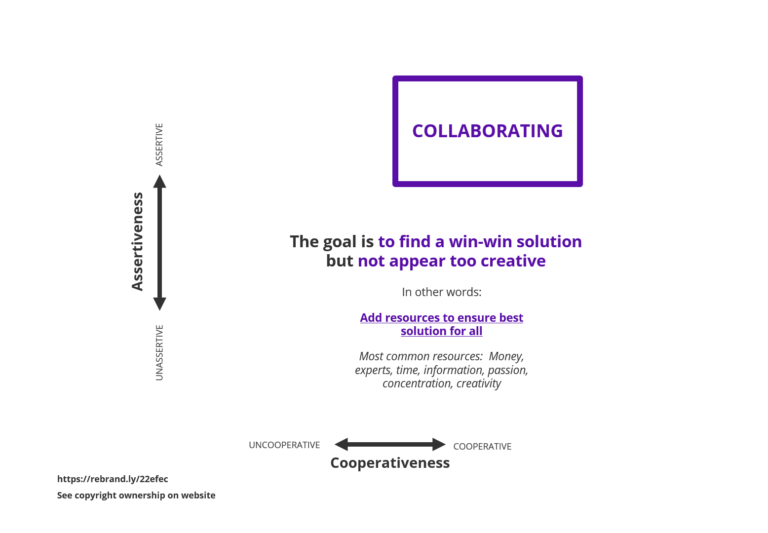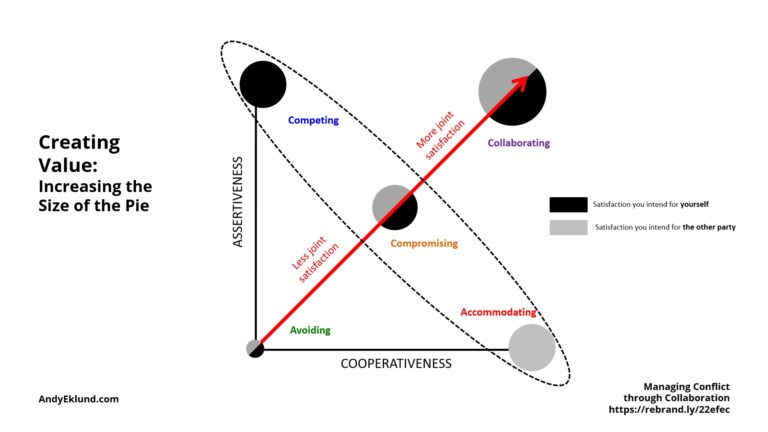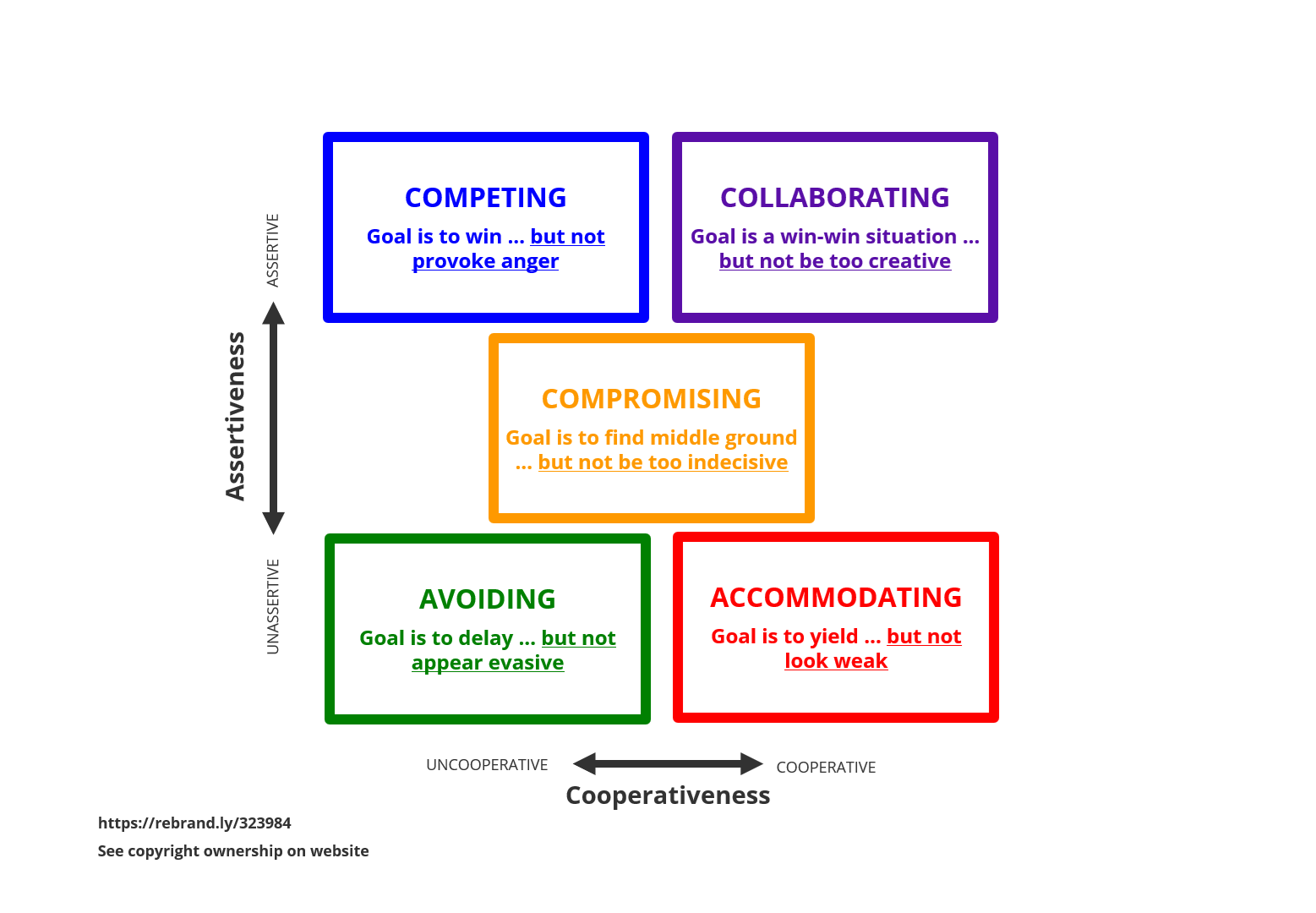This article on Collaborating is one in a series of five about managing conflict and negotiation using the Thomas-Kilmann Conflict Mode Instrument.
The introduction to the five-part series begins here. Links to the other four specific areas is at the bottom of this post.
The Only True Win-Win Situation
Collaborating is the fifth mode of conflict, when a person chooses to be assertive (they satisfy their own concerns), and cooperative (they satisfy the other person’s concerns).
Of all five modes, this is the only one that is truly a win-win situation because both parties fully realise their concerns to find a beneficial solution, but at the same time, find they’ve actually gained more than just their basic needs.
In other words, both sides “win” more than they thought they’d win.
A Popular Mode, but Not Always Reasonable
Because Collaborating outcomes are often (seem) most desirable, it’s understand why people also believe this mode is the most preferable for every situation – but that’s not always true.
Yes – at the beginning of any conflict situation – you might want to first consider whether a Collaborating mode is possible or appropraite, such as:
- Do have the time, energy, personalities and resources to spend creating the highest quality decision? Collaboration requires the most intense use of resources, such as money, experts, time, information, passion, concentration or creativity. (More about the last point in a second.) In other words, if you need a fast, immediate solution, Collaborating is not the right mode.
- Will there be an ability to surface the real issues which may mask the true conflict? Collaborating means bringing these problems out into the open. In other words, if one or both parties find it psychologically confronting or offending, Collaborating is not the right mode.
- Is there a lack of trust or an aversion to risk? Uncovering and analysing the real issues means both parties must reveal elements of the issue, or the organisations, or themselves. In other words, if either party fells the other side may exploit this openness or flexibility, Collaborating is not the right mode.
- Do both sides feel strongly about the issues, and so, both sides must address this concerns without compromising? In other words, if one party is less than interested than the other, Collaborating may not be the right mode.
Also, to collaborate most successfully, both parties bring and combine their insights to create a richer understanding. This combination of information and its essential understanding requires a specific skill that many don’t immediately link to managing conflict: your ability to be creative.
Conflict and Creativity?
It might seem odd that these two elements would be compatible in negotiation a solution. In truth, creativity is arguably the most important asset a negotiator needs.
To be Collaborative, the negotiator – hopefully working together with the other parties – needs to brainstorm all of the ways that the interests of both can be met, together. This means they need to ideate all of the potential suggestions, offers or possibilities that can be put forward to accommodate the collective and respective interests. Therein lies the Catch-22.
In their book, Getting To Yes, authors Roger Fisher, William Ury, and Bruce Patton write that many people find it difficult to be creative even in the most relaxed situations. To be creative in a tense situation would be next to impossible, and would erode – if not erase – their confidence.
The point is good negotiations always think of all of these potential solutions in advance of the actual negotiation, not on the spot. That’s why every negotiation methodology talks about “expanding the pie” to create the most value in a Collaborative solution.
Creating Value by Increasing the Size of the Pie
The smallest circle is Avoiding with the least amount of joint satisfaction. The three circles inside the dotted line are equal, although the level of satisfaction is different depending upon the mode. The circle at the top right – Collaborating – is largest because both parties have invested more into the conflict and, as a result, they’ve increased the size of the pie. That’s why Collaborating is most satisfactory: they’ve used creative thinking to expand what’s possible.
If Collaborating is the Most Appropriate Option ...
Here are some questions to inspire your creativity and create better options and situations which increase the size of the pie for all parties.
How can you put yourself in the shoes of the other party?
One of the simplest ways to begin brainstorming is to see the negotiation from the perspective of the other party. In fact, understanding their point-of-view is critical to the conflict or negotiation process, because their thinking is the problem. Asking the right questions it the first step, preferably open questions which probe for understanding about the issue, to learn what they want vs. what they need.
It’s also important to look at others perspectives as well, because they have less at stake, and perhaps might have more objectivity. In the first negotiation skills workshops I attended as a participant, the lead facilitator stressed the importance of looking at any conflict from every perspective. He used the children’s story Jack & Jill to make his point. If Jack & Jill decided to sue for negligence, who else would have an opinion? We came up with a list of people including the bucket manufacturer, the people who wanted the water, an engineer who specialised in inclines and declines, Jack’s/Jill’s parents, the water source at the top of the hill, their medical insurance, the competition (where else could people get water?), etc. In your conflict, who else has an interest, a point-of-view, or an opinion?
What is your common ground? Where do you agree?
Another key element of Collaborating: to find those areas where both parties have agreement. Where do both parties want the same outcome? Another tactic may be to start at the end, and work backwards from the mutually desireable result. Often the trick of looking at the process in reverse can be helpful to brainstorm different outcomes or solutions.
You might think there are none, and they’re easy to overlook. Often an objective person can help you or the other party see them. But the idea remains that the best negotiation and conflict resolution is when both parties see themselves as two judges sitting side by side to determine the most beneficial outcome … not to opposing parties.
What have others – in similar situations – done as a Collaborative approach?
As part of the background investigation, it’s often extremely helpful to look at what others have done in similar situations. Yes, a quick Google or Yahoo search is fine – but it’s also worth the time and expense to have a quality researcher do a more extensive and thorough search so you have context for your conflict resolution.
Who are others – people not affiliated with either party, or who have no stake in the outcome – who can help us brainstorm ideas and solutions?
Just as its helpful to have people not associated with the creative problem to help brainstorm ideas, it’s equally helpful to get people not associated with the conflict to give ideas, thoughts or opinions. Again, in the heat of a conflict or negotiation, it’s easy to overlook the obvious. A fresh pair of ideas, or someone with a different background or culture can be helpful to suggest different options.
How can we turn the concerns of the other party into a positive light?
This is perhaps the most difficult, but at the same time, the most fruitful too. Every negative aspect to one party can have a beneficial element, and once you can discover those, you may have rich territory to move the collaboration forward.
In this area of Collaboration, what are your experiences in managing conflict or negotiation? Please share your thoughts and stories in the Comments section below.
This article is my own interpretation of TKI. The artwork is my own.
All copyright is owned by Kenneth W. Thomas & Ralph H. Kilmann (1974), “Conflict Mode Instrument,” XICOM Incorporated, 33rd Printing, 1991.
As a reminder, the series about the TKI instrument begins here.
For each individual post, click on the following:





No comment yet, add your voice below!